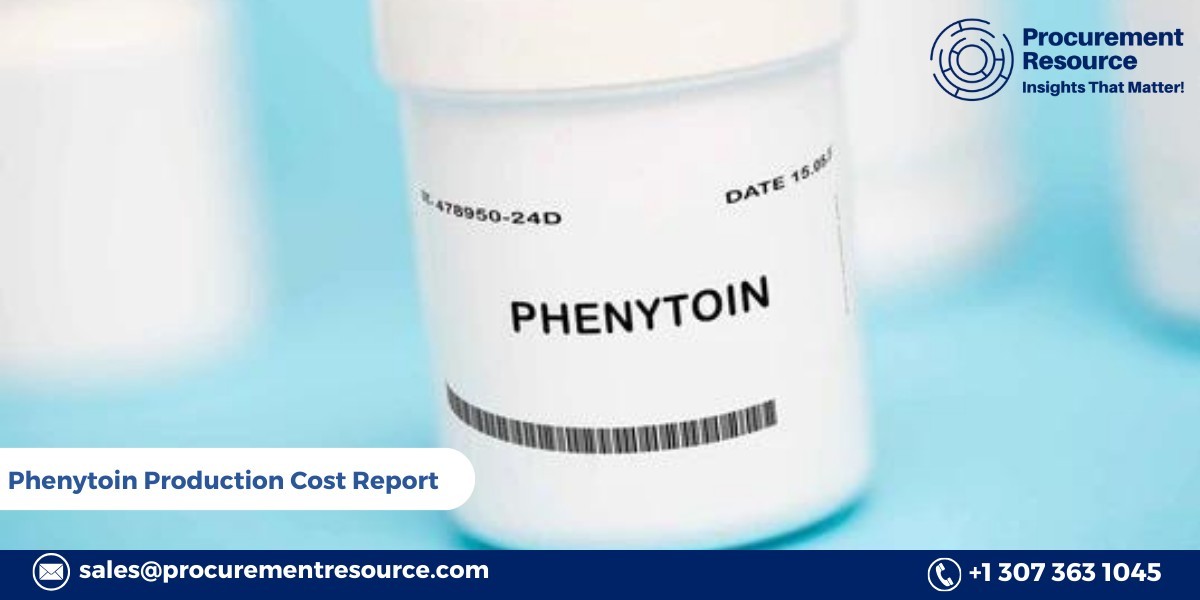Procurement Resource, a trusted provider of procurement intelligence and cost analysis solutions, presents its latest Phenytoin Production Cost Report. This detailed report offers deep insights into the cost structures, production technologies, economic feasibility, and supply chain dynamics related to phenytoin manufacturing. Whether you're a pharmaceutical enterprise, investor, or R&D firm, this report is an essential tool for strategic decision-making in the antiepileptic drug market.
Phenytoin: A Widely Used Anticonvulsant
Phenytoin (C₁₅H₁₂N₂O₂), also known by its brand name Dilantin, is a well-established antiepileptic drug (AED) primarily used to manage and prevent seizures, particularly in epilepsy and post-traumatic brain injury scenarios. It operates by stabilizing neuronal membranes and reducing repetitive firing through voltage-gated sodium channel inhibition.
Due to its long-standing efficacy, low cost, and global demand in essential medicine programs, phenytoin remains a cornerstone in neurology and general medicine. Its production, therefore, plays a critical role in pharmaceutical supply chains, especially in developing countries where cost-effective seizure control is vital.
Phenytoin Production Process Overview
Phenytoin is typically synthesized via chemical synthesis routes starting from basic organic intermediates, with urea and benzoin (or benzil) being core precursors.
Key Raw Materials:
- Benzil (or Benzoin)
- Urea
- Potassium hydroxide or other alkaline catalysts
- Acetic acid or ethanol (as solvents)
- Activated charcoal (for purification)
- Water and steam (utilities)
Step-by-Step Process:
- Condensation Reaction: Benzil is reacted with urea in the presence of a strong base (typically KOH or NaOH) under heat. This leads to the formation of phenytoin via cyclization.
- Crystallization and Neutralization: The reaction mass is acidified (commonly using acetic acid), and phenytoin is precipitated out as crystals.
- Filtration and Washing: The product is filtered, washed to remove impurities, and dried.
- Purification: Recrystallization or activated carbon treatment may be applied to meet pharmaceutical-grade purity.
- Final Processing: The purified phenytoin is dried, milled, and either packed in bulk API form or formulated into tablets or injectables.
Technology and Machinery Requirements
Manufacturing phenytoin requires precision and adherence to pharmaceutical standards. The process is predominantly batch-based, scalable from lab to industrial levels.
Core Equipment Includes:
- Chemical reactors (glass-lined or stainless steel)
- Crystallizers and condensers
- Centrifuges and filtration units
- Dryers (vacuum tray or rotary)
- Solvent recovery systems
- Milling and blending units
- Analytical testing equipment (HPLC, FTIR, etc.)
The report provides scale-dependent equipment needs and estimates for pilot, medium, and large-scale production facilities.
Infrastructure and Utilities Assessment
To ensure GMP compliance and operational efficiency, several infrastructure elements are necessary:
- Cleanroom production zones
- Water treatment and purification systems (WFI)
- HVAC systems for climate control
- Power backup systems and steam generators
- Effluent treatment plants (ETPs) for chemical discharge management
Utilities such as electricity, purified water, steam, and compressed air contribute significantly to the operating cost. The report details these needs for different manufacturing capacities.
Raw Material Price Analysis and Volatility
The cost of raw materials like benzil, urea, and solvents has a direct impact on phenytoin's production cost. Prices can vary depending on:
- Crude oil-derived solvent market trends
- Agricultural inputs for urea
- Global chemical feedstock availability
Procurement Resource tracks monthly and quarterly pricing trends, historical data, and forecasts for all critical raw materials used in phenytoin production.
Global Market Dynamics
Phenytoin maintains high demand due to its inclusion in the World Health Organization’s (WHO) Essential Medicines List. The global market is driven by:
- High incidence of epilepsy in low- and middle-income countries (LMICs)
- Demand for low-cost generics in public health systems
- Usage in emergency medicine for seizure control
- Expanding applications in neurology protocols
Regional Demand Overview:
- Asia-Pacific: Dominates production and consumption; India is a major producer and exporter.
- Africa & Latin America: Growing demand through public health initiatives.
- North America & Europe: Saturated markets but consistent procurement for essential care and veterans' health programs.
Manpower and Labor Cost Estimation
Phenytoin production, though not highly labor-intensive, requires skilled personnel to ensure quality and compliance:
- Process chemists and API specialists
- GMP-certified production supervisors
- QA/QC analysts
- Maintenance engineers and safety officers
The report includes a breakdown of labor costs by geography, skill level, and operational model (shift-based, continuous, or batch).
Regulatory and Quality Compliance
As a pharmaceutical compound, phenytoin manufacturing is subject to stringent regulatory oversight, especially for international trade:
- Good Manufacturing Practices (GMP) compliance
- FDA, EMA, and WHO PQ approvals for export
- Pharmacopoeial conformity: USP, Ph. Eur., IP standards
- Documentation including Drug Master Files (DMF), Certificates of Analysis (CoA), and validation reports
The report elaborates on quality control testing (HPLC, NMR, dissolution), required certifications, and global compliance standards.
Capital Investment and Operating Cost Breakdown
The report provides a detailed breakdown of Capital Expenditure (CapEx) and Operational Expenditure (OpEx) required to set up and run a phenytoin production facility.
CapEx Includes:
- Land and facility development
- Machinery and equipment procurement
- Validation and installation
- Licensing and regulatory filing fees
OpEx Includes:
- Raw material procurement
- Energy and utility consumption
- Labor and supervision
- Maintenance and waste management
- Quality assurance and compliance costs
Cost modeling includes per kg API cost, batch-wise cost tracking, and plant utilization scenarios.
Profitability Analysis
Procurement Resource offers a detailed economic outlook and profitability metrics based on market data and financial modeling:
- Break-even analysis
- Gross and operating margin forecasts
- Net Present Value (NPV) and Internal Rate of Return (IRR)
- Payback period estimation under different market scenarios
These insights help stakeholders assess the financial viability and scalability of investing in phenytoin manufacturing.
Sustainability Trends
While phenytoin synthesis is largely chemical-based, there's an increasing push toward:
- Green solvents and solvent recovery systems
- Waste minimization and zero liquid discharge (ZLD) processes
- Adoption of continuous flow chemistry to reduce emissions and energy use
The report highlights such sustainability initiatives and their impact on cost, compliance, and brand reputation.
Get Your Free Sample Report
Our Phenytoin Production Cost Report is an indispensable resource for businesses looking to optimize their manufacturing strategy or explore API production ventures.
Request Free Sample: https://www.procurementresource.com/production-cost-report-store/phenytoin/request-sample
Why Choose Procurement Resource?
Procurement Resource stands out for its:
- Accurate and transparent cost modeling
- Industry-aligned process and market insights
- Customized reports tailored to investors, manufacturers, and researchers
- Robust support in procurement planning and feasibility analysis
Contact Procurement Resource
Company Name: Procurement Resource
Contact Person: Ashish Sharma
Email: sales@procurementresource.com
Location: 30 North Gould Street, Sheridan, WY 82801, USA
Phone:
UK: +44 7537171117
USA: +1 307 363 1045
APAC: +91 1203185500


